What not to do: When transactional emails become too robotic
One of the biggest challenges faced by SaaS founders is making their businesses feel human, relatable. In the modern era of the internet, consumers value the feeling that they can connect with a business beyond the boilerplate interactions they’re used to.
Building up a persona is one of the key ways you can stand out in the hailstorm of content online.
We as businesses understand this and put a huge amount of work into crafting our communications for optimum engagement. Landing pages, content, web copy, marketing materials and more are consistently optimized for sharp messaging and have that personable, fun edge.

Despite all of the work going into 21st-century persona branding, there’s a hole in the bucket: the transactional emails that often have a big impact on our customers feel cold, stale, and robotic.
And on the one hand, it makes sense- after all, you need customers to trust that these messages are reputable. They’re entering sensitive personal information.
Thing is, you’re missing out on key opportunities to connect more deeply with your customers and build a positive brand experience into the simplest interactions they have with you.
So what do transactional emails look like for your business? You’re likely sending:
- Password resets
- Order Confirmations
- Email receipts
- Payment failure notifications (known as 'dunning')
- Subscription renewals
- And more...
Alongside the meaningful impacts these messages have on your customer’s experience, each of these messages is also deeply tied to your overall bottom line.
So why are we letting them become so robotic and automatic?
The first step to improving your communication strategy is using a transactional email provider that allows you to brand, personalize, and optimize these emails. From here, let’s dig into the ways that you can make transactional emails a positive experience for your customer base.
Honor the customer experience #
No matter what, you want to provide the best experience possible every time a customer interacts with you. When analyzing your transactional emails, start by taking the customer’s perspective.
A password reset is a quick response to solve a frustrating issue. Order confirmations and email receipts give your customers peace of mind that their request has been received and are often vital for their record-keeping. Trial ending emails ensure your customers know they’re not being duped into paying without notice.
In each of these situations, your team is providing a service, not simply initiating a mechanical response to a problem. Your materials should reflect this in a courteous, helpful manner.
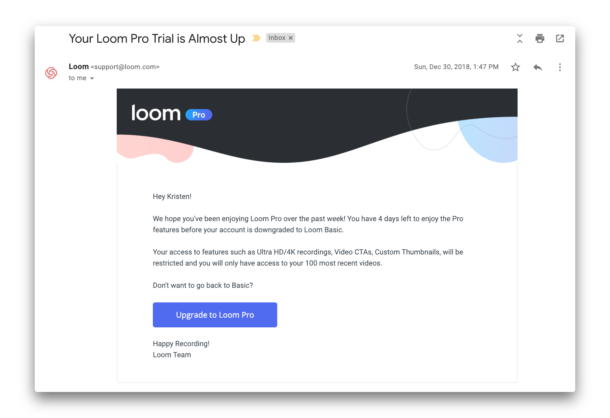
Dunning and subscription renewal emails help your customers to continue using a service they value. The catch here is that they also come with a monetary request. At this point in the customer journey, they are making the decision to stick with you, and your communications should reflect that.
You have a chance to nudge them in the right direction and show off the ways that you already improve their day-to-day functioning. Use it wisely.
PS: we think dunning emails are so crucial to your business they deserve a separate chapter... so here it is: 6 dunning email examples (and a free template) for you to learn the dos and don'ts of getting these emails done right.
Respect your customer’s time #
While online businesses generally thrive on consistent, open-ended communication, transactional emails require a specific, nuanced approach.
In a nutshell: if you don't absolutely need to bother your customer with a transactional email, don’t.
For example, pre-dunning, or sending emails warning customers before a card expires, is an archaic tactic that will likely frustrate your users.
Used to be, you would reach out to customers thirty days, fifteen days, three days before their card was set to expire. It was irritating, sure, but given the available technology it was necessary for you to get paid and your customer to continue seamless use of your service.
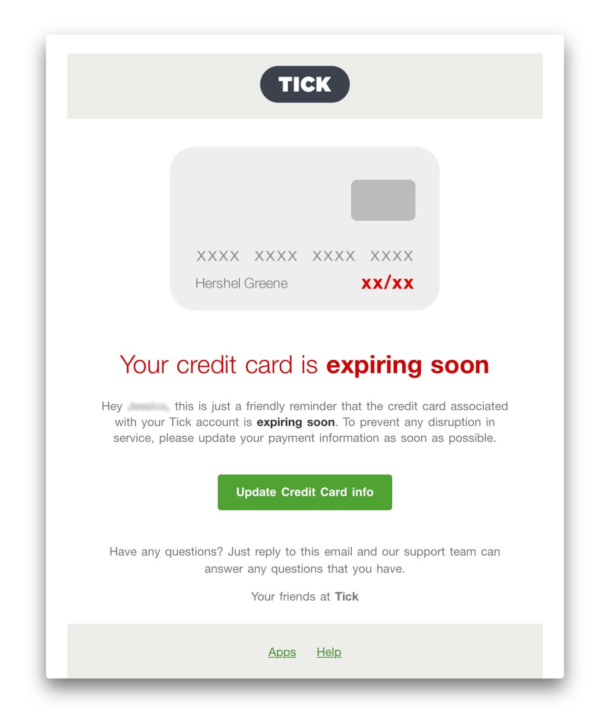
These days, one in five failed payments can be solved by simply retrying the same card.
Services like Stripe offer card updater services that are effective for over 70% of cards that are set to expire. The fact of the matter is that you can take care of the vast majority of your dunning behind the scenes without ever bothering your customers.
We need to start looking at all transactional emails in this light. How can I best serve my customer without unnecessarily bothering them?
Overdoing it on transactional emails like pre-dunning can have a “boy who cried wolf” effect- i.e. when customers receive too many messages in this vein, they can slip down the priority list and may not get opened when it’s really necessary.
Have a little fun
#
Okay, so you should absolutely respect your customer’s time, but that doesn’t mean you can’t also have a little fun. Bringing some brand personality into this side of your messaging can go a long way.
From password resets to card update emails, you have the opportunity to increase trust and turn a frustrating day-to-day task into an enjoyable experience.
Take a look at this example of a dunning email from Death to Stock.
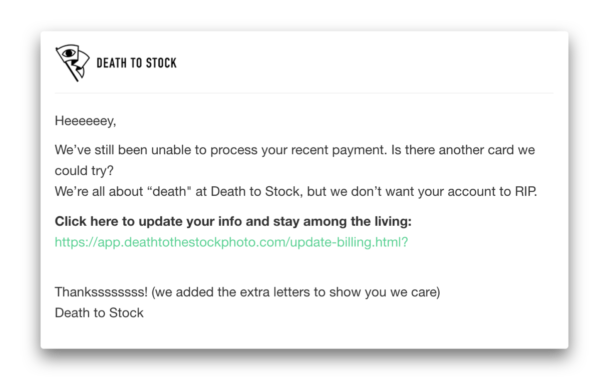
First thing’s first: the messaging starts with a humorous greeting, but it also moves directly into the “ask” of the message. It gets right to the point, then includes a couple of fun brand-oriented notes alongside the important information.
They manage to get it all across in the space of about four sentences- essentially compressing both information and personality into a clear, manageable CTA.
Genuine, human messaging like this is great from a business perspective because it’s memorable. It helps you to stand out and adds a personal touch to messaging that is so often robotic and insincere.
It speaks to your customers not as users, but as people.
Here’s another great example from the folks at Wistia.
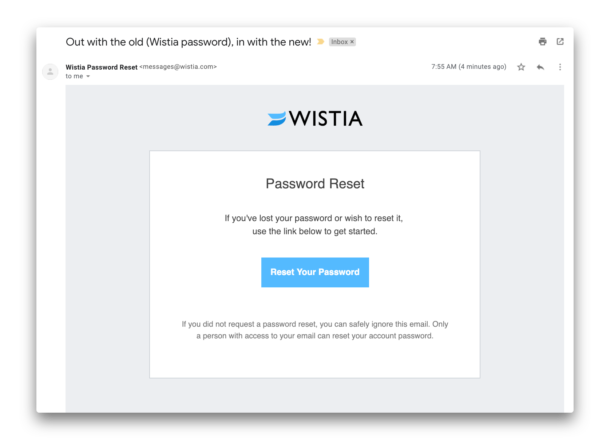
Take a look at that subject line for starters. It’s a fun spin on a classically “boring” email. From there, it’s branded with clean, recognizable assets, providing trust for the customers.
Small tweaks can make a huge difference in the success of your transactional emails. Make these communication points more human, genuine, and yes, even a bit more fun when it’s appropriate. You know your users best, so follow your best brand guidelines and apply them to transactional emails.
Be transparent #
First thing’s first: getting these messages into your customer’s inbox is vital. Third party delivery systems that exist for exactly this purpose can be a fantastic tool, but there are a few things to keep in mind.
While much of this process can be automated, you need to do some work before you set it and forget it.
Emails should generally come from a recognizable name with an address from your domain- “white-labeled” in industry terms. This creates the initial layer of trust your customers need to open the message.
You’ll want to send these emails via a different channel from your newsletter and other communications. This lets customers know that an email is related more directly to the status of their account and requires action on their end.
The trick here is establishing authority and trust for these messages. Always send your customers to secure pages. Monetary emails like dunning and subscription reactivations need to be clearly from you, and not phishing schemes.
From here, well-crafted branding goes a long way. Emails that echo the style and navigation of your website give that extra layer of recognition, as well as helping you to stand out amidst all the other similar messages in their inbox.
Monitor deliverability
#
I know I said you could set and forget your transactional emails, but that’s only partially true. While the basic framework of this system in an investment at the front end that will pay dividends over time, you need to check in on your processes regularly to keep them working at top efficiency.
What if someone never gets a dunning email because their contact information is out of date? What if your password reset emails are bouncing?
These issues can make the jump to bad customer experiences (and cancellations) quickly.
Make sure you’re taking regular dives into your analytics and looking specifically for leaks. Set up alerts for bounced emails. Slack is a great tool for getting these messages directly to you with no downtime, so your team can act when necessary.
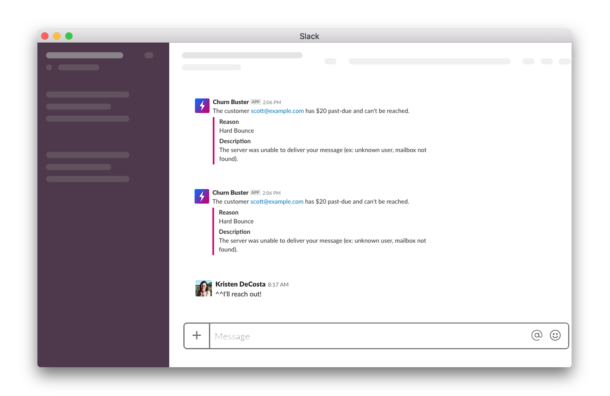
Basically, don’t gamble on these vital messages. Don’t let your approach to transactional emails become robotic once you’ve just spent the time to breathe life into their content. Consistently refine your processes and recognize that the work is never done. Not really.
Pay attention to the little things #
We’ve talked about a lot here, but really it all comes down to the customer experience. Your users are humans with feelings, moods, and differing levels of satisfaction with your service. You have a chance to build interactions that consistently improve their relationship with your business.
Paying attention to the little things adds up over time to create a meaningful brand experience. Even small tweaks to the overlooked elements of your messaging can make a huge difference in building up customer loyalty and setting your business up for long-term retention.


